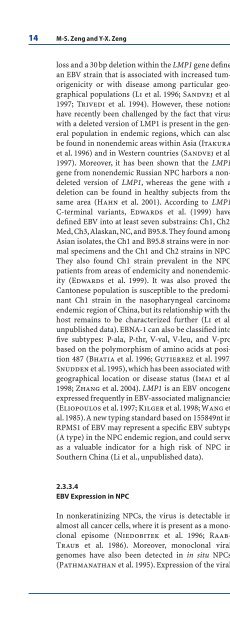Familial Nasopharyngeal Carcinoma 6
Familial Nasopharyngeal Carcinoma 6
Familial Nasopharyngeal Carcinoma 6
- No tags were found...
Create successful ePaper yourself
Turn your PDF publications into a flip-book with our unique Google optimized e-Paper software.
14 M-S. Zeng and Y-X. Zengloss and a 30 bp deletion within the LMP1 gene definean EBV strain that is associated with increased tumorigenicityor with disease among particular geographicalpopulations (Li et al. 1996; Sandvej et al.1997; Trivedi et al. 1994). However, these notionshave recently been challenged by the fact that viruswith a deleted version of LMP1 is present in the generalpopulation in endemic regions, which can alsobe found in nonendemic areas within Asia (Itakuraet al. 1996) and in Western countries (Sandvej et al.1997). Moreover, it has been shown that the LMP1gene from nonendemic Russian NPC harbors a nondeletedversion of LMP1, whereas the gene with adeletion can be found in healthy subjects from thesame area (Hahn et al. 2001). According to LMP1C-terminal variants, Edwards et al. (1999) havedefined EBV into at least seven substrains: Ch1, Ch2,Med, Ch3, Alaskan, NC, and B95.8. They found amongAsian isolates, the Ch1 and B95.8 strains were in normalspecimens and the Ch1 and Ch2 strains in NPC.They also found Ch1 strain prevalent in the NPCpatients from areas of endemicity and nonendemicity(Edwards et al. 1999). It was also proved theCantonese population is susceptible to the predominantCh1 strain in the nasopharyngeal carcinomaendemic region of China, but its relationship with thehost remains to be characterized further (Li et al.unpublished data). EBNA-1 can also be classified intofive subtypes: P-ala, P-thr, V-val, V-leu, and V-probased on the polymorphism of amino acids at position487 (Bhatia et al. 1996; Gutierrez et al. 1997;Snudden et al. 1995), which has been associated withgeographical location or disease status (Imai et al.1998; Zhang et al. 2004). LMP1 is an EBV oncogeneexpressed frequently in EBV-associated malignancies(Eliopoulos et al. 1997; Kilger et al. 1998; Wang etal. 1985). A new typing standard based on 155849nt inRPMS1 of EBV may represent a specific EBV subtype(A type) in the NPC endemic region, and could serveas a valuable indicator for a high risk of NPC inSouthern China (Li et al., unpublished data).2.3.3.4EBV Expression in NPCIn nonkeratinizing NPCs, the virus is detectable inalmost all cancer cells, where it is present as a monoclonalepisome (Niedobitek et al. 1996; Raab-Traub et al. 1986). Moreover, monoclonal viralgenomes have also been detected in in situ NPCs(Pathmanathan et al. 1995). Expression of the viralgenome in nonkeratinizing NPC has been studiedextensively. During latency, up to 11 viral genes areexpressed that encode up to nine proteins and EBVinfection in NPC is classified as latency type II, whichis characterized by expression of the EBERs, EBNA1,LMP1, LMP2A, and the Bam H1 A transcripts, despiteLMP1 is only expressed in up to approximately 65%of nasopharyngeal carcinoma tumors (Niedobiteket al. 2000; Young et al. 2000). While remaining latent,EBV can induce RNA and protein production. Recentevidence demonstrated the association of distinctlytic promoter sequence variation with NPC inSouthern Chinese and suggested the participation ofa lytic-latent switch of EBV in NPC carcinogenesis(Tong et al. 2003).In NPC cells, the virus is in the form of episomeand not integrated into the host genome. LMP1 andBARF1 have profound effects on cellular gene expressionand may contribute to EBV-mediated tumorigenesis.In vitro, LMP1 expression in epithelial cells caninduce or upregulate the expression of intercellularadhesion molecule 1 (ICAM-1), CD40, and cytokinessuch as interleukin 6 (IL-6) and IL-8 (Dawson et al.1990; Eliopoulos et al. 1997). Expression of LMP1 inimmortalized nasopharyngeal epithelial cells inducesan array of genes involved in growth stimulation,enhanced survival, and increased invasive potentials(Lo et al. 2004). Blocking the important signalingactivities of LMP1 abrogates transformation and testifiesto the importance of such events in the transformationprocess (Murray et al. 2000). BARF1 is able toimmortalize primate epithelial cells and enhancegrowth rate of the transfected cells (Wei et al. 1997). Afamily of rightward transcripts from the BamHI Aregion was initially identified in cDNA libraries fromNPC where they are abundantly and consistentlyexpressed (Gilligan et al. 1991).2.3.3.5The Role of EBV in the Pathogenesis of NPCBiology of EBV InfectionApproximately 90% of the adult population throughoutthe world is EBV-positive by serology (Lo et al.2004). After primary infection at early age, persistentEBV latent infection is found in some resting B cells,but has not been detected in the nasopharyngeal epitheliaof healthy individuals (Babcock et al. 1998;Tao et al. 1995). However, EBV infection has beendemonstrated in situ carcinomas of the nasophar-











